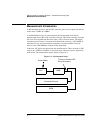
Measurement Uncertainty Analysis – Instrument Accuracy Test
Measurement Introduction
Agilent E4416A/E4417A Service Guide A-3
Uncertainties
1. There is no uncertainty involved within the 8482A sensor, as a relative power is being measured. Before any
measurement is made, an equivalent voltage to 0dBm is applied to the 8482 sensor to allow the power meter calibration.
It is not important if the sensor creates an offset during this calibration procedure, provided this offset is present
throughout all the different power levels. The 8482A sensor is linear from –25dBm up to 0dBm, and hence the same
offset would always be present. Between 0dBm and 20dBm, look up tables are employed to counteract the non-linear
behavior of the sensor at higher power levels.
Example: Consider a DC voltage from the Universal Source applied to the 8482A sensor, producing a power of 0.2dBm
instead of 0dBm (for example, a 0.2dBm offset). The measuring device (for example, the power meter) takes this
0.2dBm value as being 0dBm, and adjusts itself accordingly. Now throughout every measurement level, the 8482A and
the power meter has the same 0.2dBm offset (because the sensor is linear).
Define the Measurand
The measurand is the Measurement Accuracy of the DUT.
Define the Measurement Equation
Note Test Station Error (TSE) is the error contribution of the cables, connectors, noise,
and so forth, that cannot be measured independently.
Note The measurement uncertainty only relates to the test station, in this case, a power
meter is the most accurate method of measuring power. Hence the reason the
DUT Measure component can be ignored in the measurement equation.
However, taking a number of measurements of the test system with the same
power meter, averages out the error resolution or minimize it to the extent where
the magnitude error is many times smaller than the station error.
Universal Source: No Uncertainties
DMM: Yes (Type B)
8482:
No
1
Extraneous signals, cables connectors and Yes (Type A)
Measurement Accuracy = DUT Measure - Test System Power
Where:
Test System Power = (Measure voltage x Volts/Power Conversion) + Test Station Error


















